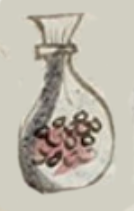xinachtli seda (CST37)
This painting of the simplex glyph for the term xinachtli seda (silk eggs) shows a frontal view of a sack that is synched and tied at the top and rounded at the bottom. The sack is white, but the artist painted on the exterior of the bag some of the eggs that are inside it. The eggs are little circles drawn in black ink with a little bit of red colorant over them. The sack has vertical lines above the tie and a shadow in gray on the left side, all in an effort to give the bag three-dimensionality.
Stephanie Wood
The term xinachtli usually refers to seeds, but one does not plant seeds and grow silk. Silk is a spun protein that comes from the cocoons of caterpillars that feast on mulberry leaves. These silkworm eggs were hatched in blankets. Eventually, the moths would form cocoons. For some glyphs of seeds of other types, see below. For more on the Codex Sierra, see Kevin Terraciano’s study (2021), especially the section on the silk industry, pp. 77–83.
Stephanie Wood
1550–1564
Jeff Haskett-Wood
granos, semillas, textiles

xinach(tli), seeds, https://nahuatl.wired-humanities.org/content/xinachtli
seda, silk (a Spanish loan that was taken into Nahuatl), https://nahuatl.wired-humanities.org/content/seda
granos de seda
Stephanie Wood
Códice Sierra-Texupan, plate 37, page dated 1561. Origin: Santa Catalina Texupan, Mixteca Alta, State of Oaxaca. Kevin Terraciano has published an outstanding study of this manuscript (Codex Sierra, 2021), and in his book he refers to alphabetic and “pictorial” writing, not hieroglyphic writing. We are still counting some of the imagery from this source as hieroglyphic writing, but we are also including examples of “iconography” where the images verge on European style illustrations or scenes showing activities. We have this iconography category so that such images can be fruitfully compared with hieroglyphs. Hieroglyphic writing was evolving as a result of the influence of European illustrations, and even alphabetic writing impacted it.
https://bidilaf.buap.mx/objeto.xql?id=48281&busqueda=Texupan&action=search
The Biblioteca Digital Lafragua of the Biblioteca Histórica José María Lafragua in Puebla, Mexico, publishes this Códice Sierra-Texupan, 1550–1564 (62pp., 30.7 x 21.8 cm.), referring to it as being in the “Public Domain.” This image is published here under a Creative Commons license, asking that you cite the Biblioteca Digital Lafragua and this Visual Lexicon of Aztec Hieroglyphs.









